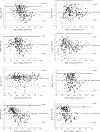Validity of devices that assess body temperature during outdoor exercise in the heat
- PMID: 18059987
- PMCID: PMC1978469
Validity of devices that assess body temperature during outdoor exercise in the heat
Abstract
Context: Rectal temperature is recommended by the National Athletic Trainers' Association as the criterion standard for recognizing exertional heat stroke, but other body sites commonly are used to measure temperature. Few authors have assessed the validity of the thermometers that measure body temperature at these sites in athletic settings.
Objective: To assess the validity of commonly used temperature devices at various body sites during outdoor exercise in the heat.
Design: Observational field study.
Setting: Outdoor athletic facilities.
Patients or other participants: Fifteen men and 10 women (age = 26.5 +/- 5.3 years, height = 174.3 +/- 11.1 cm, mass = 72.73 +/- 15.95 kg, body fat = 16.2 +/- 5.5%).
Intervention(s): We simultaneously tested inexpensive and expensive devices orally and in the axillary region, along with measures of aural, gastrointestinal, forehead, temporal, and rectal temperatures. Temporal temperature was measured according to the instruction manual and a modified method observed in medical tents at local road races. We also measured forehead temperatures directly on the athletic field (other measures occurred in a covered pavilion) where solar radiation was greater. Rectal temperature was the criterion standard used to assess the validity of all other devices. Subjects' temperatures were measured before exercise, every 60 minutes during 180 minutes of exercise, and every 20 minutes for 60 minutes of postexercise recovery. Temperature devices were considered invalid if the mean bias (average difference between rectal temperature and device temperature) was greater than +/-0.27 degrees C (+/-0.5 degrees F).
Main outcome measure(s): Temperature from each device at each site and time point.
Results: Mean bias for the following temperatures was greater than the allowed limit of +/-0.27 degrees C (+/-0.5 degrees F): temperature obtained via expensive oral device (-1.20 degrees C [-2.17 degrees F]), inexpensive oral device (-1.67 degrees C [-3.00 degrees F]), expensive axillary device (-2.58 degrees C [-4.65 degrees F]), inexpensive axillary device (-2.07 degrees C [-3.73 degrees F]), aural method (-1.00 degrees C [-1.80 degrees F]), temporal method according to instruction manual (-1.46 degrees C [-2.64 degrees F]), modified temporal method (-1.36 degrees C [-2.44 degrees F]), and forehead temperature on the athletic field (0.60 degrees C [1.08 degrees F]). Mean bias for gastrointestinal temperature (-0.19 degrees C [-0.34 degrees F]) and forehead temperature in the pavillion (-0.14 degrees C [-0.25 degrees F]) was less than the allowed limit of +/-0.27 degrees C (+/-0.5 degrees F). Forehead temperature depended on the setting in which it was measured and showed greater variation than other temperatures.
Conclusions: Compared with rectal temperature (the criterion standard), gastrointestinal temperature was the only measurement that accurately assessed core body temperature. Oral, axillary, aural, temporal, and field forehead temperatures were significantly different from rectal temperature and, therefore, are considered invalid for assessing hyperthermia in individuals exercising outdoors in the heat.
Keywords: core body temperature; hyperthermia; tympanic membrane temperature.
Figures



Similar articles
-
Validity and reliability of devices that assess body temperature during indoor exercise in the heat.J Athl Train. 2009 Mar-Apr;44(2):124-35. doi: 10.4085/1062-6050-44.2.124. J Athl Train. 2009. PMID: 19295956 Free PMC article.
-
Validity of field expedient devices to assess core temperature during exercise in the cold.Aviat Space Environ Med. 2011 Dec;82(12):1098-103. doi: 10.3357/asem.3102.2011. Aviat Space Environ Med. 2011. PMID: 22195389
-
Comparison of rectal, axillary, and forehead temperatures.Arch Pediatr Adolesc Med. 1996 Jan;150(1):74-8. doi: 10.1001/archpedi.1996.02170260078013. Arch Pediatr Adolesc Med. 1996. PMID: 8542011 Clinical Trial.
-
Non-Contact Thermometers for Detecting Fever: A Review of Clinical Effectiveness [Internet].Ottawa (ON): Canadian Agency for Drugs and Technologies in Health; 2014 Nov 20. Ottawa (ON): Canadian Agency for Drugs and Technologies in Health; 2014 Nov 20. PMID: 25520984 Free Books & Documents. Review.
-
Evaluation of laboratory accuracy of forehead radiation thermometers using blackbody sources for tympanic thermometers defined by international standards with adaptors.J Med Eng Technol. 2023 Jan;47(1):29-34. doi: 10.1080/03091902.2022.2096135. Epub 2022 Jul 27. J Med Eng Technol. 2023. PMID: 35895015 Review.
Cited by
-
A 3-D virtual human thermoregulatory model to predict whole-body and organ-specific heat-stress responses.Eur J Appl Physiol. 2021 Sep;121(9):2543-2562. doi: 10.1007/s00421-021-04698-1. Epub 2021 Jun 5. Eur J Appl Physiol. 2021. PMID: 34089370 Free PMC article.
-
Recommended water immersion duration for the field treatment of exertional heat stroke when rectal temperature is unavailable.Eur J Appl Physiol. 2024 Feb;124(2):479-490. doi: 10.1007/s00421-023-05290-5. Epub 2023 Aug 8. Eur J Appl Physiol. 2024. PMID: 37552243
-
Changes in gastrointestinal cell integrity after marathon running and exercise-associated collapse.Eur J Appl Physiol. 2021 Apr;121(4):1179-1187. doi: 10.1007/s00421-021-04603-w. Epub 2021 Jan 29. Eur J Appl Physiol. 2021. PMID: 33512586
-
Elevated Ambient Temperature Associated With Reduced Infectious Disease Test Positivity Rates: Retrospective Observational Analysis of Statewide COVID-19 Testing and Weather Across California Counties.JMIR Public Health Surveill. 2024 Dec 12;10:e57495. doi: 10.2196/57495. JMIR Public Health Surveill. 2024. PMID: 39665781 Free PMC article.
-
Covid-19 screening: are forehead temperature measurements during cold outdoor temperatures really helpful?Wien Klin Wochenschr. 2021 Apr;133(7-8):331-335. doi: 10.1007/s00508-020-01754-2. Epub 2020 Oct 23. Wien Klin Wochenschr. 2021. PMID: 33095321 Free PMC article.
References
-
- Dombek PM, Casa DJ, Yeargin SW. Athletic trainers' knowledge and behavior regarding the prevention, recognition, and treatment of exertional heat stroke at the high school level [abstract] J Athl Train. 2006;41:S–47. et al. (suppl)
-
- Casa DJ, Armstrong LE, Ganio MS, Yeargin SW. Exertional heat stroke in competitive athletes. Curr Sports Med Rep. 2005;4:309–317. - PubMed
-
- Costrini A. Emergency treatment of exertional heatstroke and comparison of whole body cooling techniques. Med Sci Sports Exerc. 1990;22:15–18. - PubMed
-
- Moran DS, Mendal L. Core temperature measurement: methods and current insights. Sports Med. 2002;32:879–885. - PubMed
Publication types
MeSH terms
LinkOut - more resources
Full Text Sources
Medical
